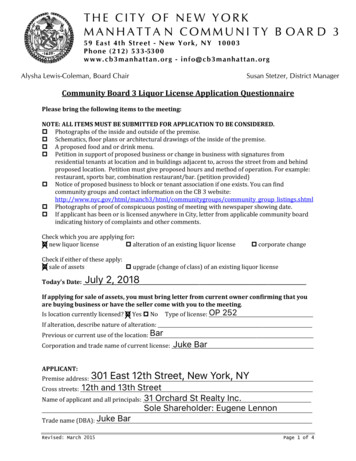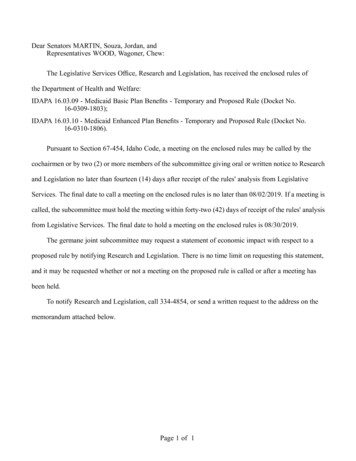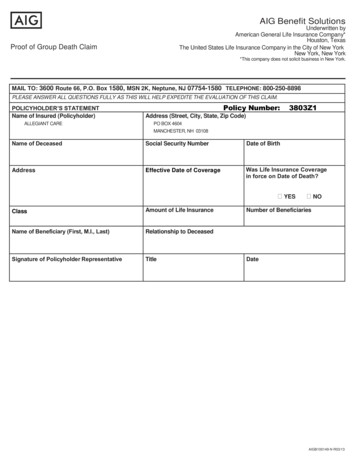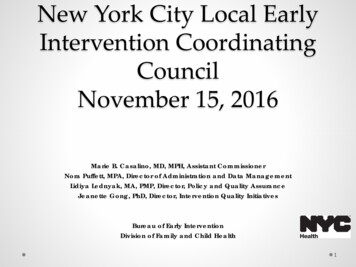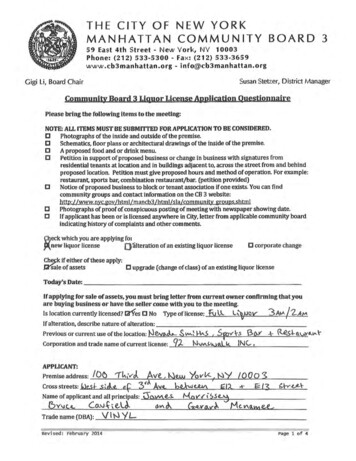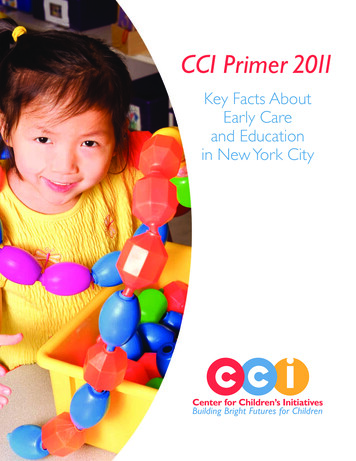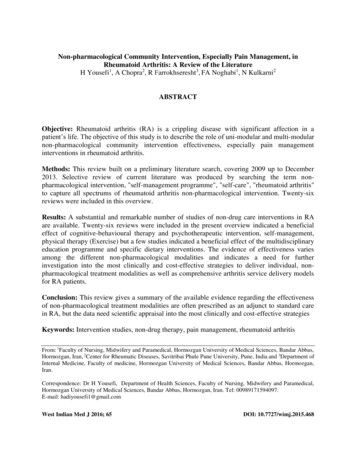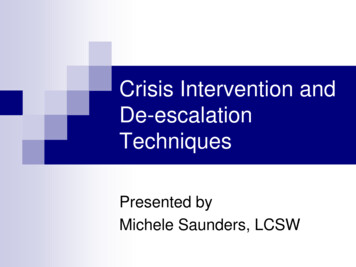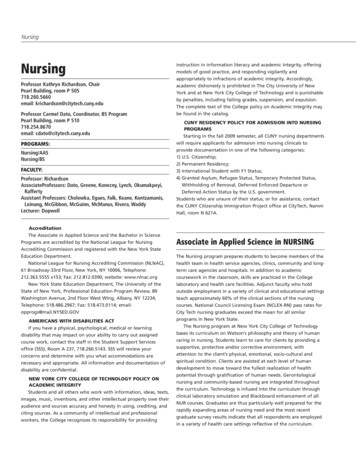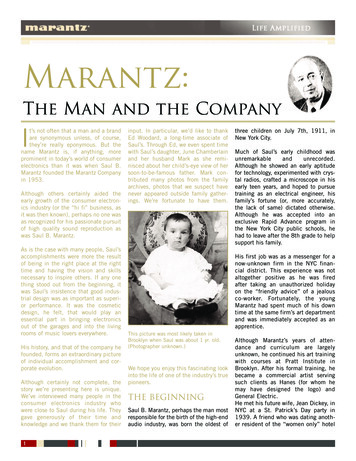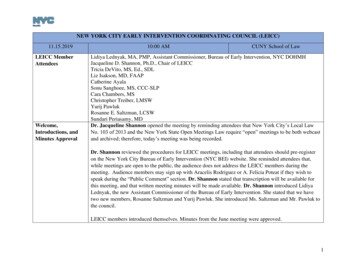
Transcription
NEW YORK CITY EARLY INTERVENTION COORDINATING COUNCIL (LEICC)11.15.2019LEICC MemberAttendeesWelcome,Introductions, andMinutes Approval10:00 AMCUNY School of LawLidiya Lednyak, MA, PMP, Assistant Commissioner, Bureau of Early Intervention, NYC DOHMHJacqueline D. Shannon, Ph.D., Chair of LEICCTricia DeVito, MS, Ed., SDLLiz Isakson, MD, FAAPCatherine AyalaSonu Sanghoee, MS, CCC-SLPCara Chambers, MSChristopher Treiber, LMSWYurij PawlukRosanne E. Saltzman, LCSWSundari Periasamy, MDDr. Jacqueline Shannon opened the meeting by reminding attendees that New York City’s Local LawNo. 103 of 2013 and the New York State Open Meetings Law require “open” meetings to be both webcastand archived; therefore, today’s meeting was being recorded.Dr. Shannon reviewed the procedures for LEICC meetings, including that attendees should pre-registeron the New York City Bureau of Early Intervention (NYC BEI) website. She reminded attendees that,while meetings are open to the public, the audience does not address the LEICC members during themeeting. Audience members may sign up with Aracelis Rodriguez or A. Felicia Poteat if they wish tospeak during the “Public Comment” section. Dr. Shannon stated that transcription will be available forthis meeting, and that written meeting minutes will be made available. Dr. Shannon introduced LidiyaLednyak, the new Assistant Commissioner of the Bureau of Early Intervention. She stated that we havetwo new members, Rosanne Saltzman and Yurij Pawluk. She introduced Ms. Saltzman and Mr. Pawluk tothe council.LEICC members introduced themselves. Minutes from the June meeting were approved.1
Introduction ofDeputyCommissioner,SEICC Report andBureau UpdatesLidiya Lednyak introduced Dr. Daniel H. Stephens, the new Deputy Commissioner of the Division ofFamily and Child Health.SEICC ReportLidiya Lednyak provided a summary of the State Early Intervention Coordinating Council (SEICC)meeting held on 9/19/2019.NYS OSEP Determination. NYS received a determination of “Fully Meets Requirements” from the Officeof Special Education Programs for Federal Fiscal Year 2017.Medicaid State Plan Amendments Update. On June 13, 2019, the Center for Medicaid Services (CMS)approved a State Plan Amendment (SPA) for Early Intervention (EI) Services, SPA 18-0039. SPA movesEI services from rehabilitative services to Early and Periodic Screening, Diagnostic, and TreatmentServices (EPSDT).State Plan Amendment Highlights. Four mental health practitioner types were added to the list ofapproved providers: Licensed Mental Health Counselor, Licensed Marriage and Family Therapist,Licensed Psychoanalyst, and Licensed Creative Arts Therapist. School Psychologist Practitioner was notadded.It should be noted that the new practitioner types approved by the SPA, cannot be utilizing in theEarly Intervention Program until State Department of Health regulations and guidance arereleased.Requirements for “under the supervision of” for Licensed Master Social Workers (LMSW) working undera plan of supervision by a LCSW include: LMSW apprises the supervisor of the diagnosis and treatmentof each client, the supervisor provides oversight and guidance in diagnoses and treatments, the supervisorregularly reviews and evaluates the work of the LMSW and the supervisor provides at least two hours permonth of in-person individual or group clinical supervision.Requirements for “under the direction of” applies to all other types of therapists working under a plan ofsupervision. “Under the direction of” means that the supervisor: Sees the participant at the beginning ofand periodically during the course of treatment and is familiar with the treatment plan; has continuedinvolvement in the care provided and reviews the need for continued services throughout treatment;2
assumes responsibility for the services provided under his/her direction; spends as much time as necessarydirectly supervising services to ensure child and family are receiving services in a safe and efficientmanner in accordance with accepted standards of practice; and keeps documentation supporting thesupervision of services and ongoing involvement in the treatment.SPA clarifies some covered activities for common EI service types: Speech Language Pathology,Occupational Therapy, and Physical Therapy services may be provided to a child’s caregiver when theydirectly benefit the child. Special Instruction services including activities that extend into the child’s dailyroutines and promote developmental skills such as: Motor development, physical growth anddevelopment, sensory perception and information processing, behavioral interactions, cognitive processesand social interactions. The claiming process for transportation will also be changing as a result of thisSPA.Provider Workforce Capacity Task Force Update. The charge for this task force is to developrecommendations for the NYS Department of Health to increase EI provider workforce capacity. Topicsdiscussed: Connections with high schools, colleges and universities that prepare students/potential EIservice providers; review of the 1600-hour requirement; conditional approval of EI providers; qualityassurance plans and professional requirements; service delivery methods or models to enhance capacity inunderserved areas/zip codes; and technology solutions /GIS Locator/Information-Sharing.DiscussionChristopher Treiber inquired about getting feedback from individuals doing EI work. Dr. Shannonresponded that at Brooklyn College they have almost 500 students who are early childhood educationmajors, half of them special education. Brooklyn College started to integrate more EI content at theundergrad level and was seeing more student interest in going into EI. Lidiya Lednyak stated that there isa lot happening in New York City particularly with the academic partnerships, but that's not happening inthe rest of the state. Part of the role of this work group will be to share what the EI Program has done inNew York City and some of the challenges we faced.Work Group for Dissemination of the Social Emotional Development Guidance. The charge is to facilitatethe dissemination and promote the use of the Guidance Document in the EI Program.3
Project Workgroups: E-Learning-Use of Guidance Document for EIP workforce; total of sixmodules. Date completed: 8/20/19.Webpage-On social-emotional development for families. Launched: 11/30/18.Desk Aides-Documents to help address social-emotional development with familiesthroughout the EIP process.Update on RFP to Support Operational Management of the EIP and NYEIS Update. The NYS Departmentof Health RFP 17744, Support for Operational Management of the EIP, was awarded to Public ConsultingGroup Inc.(PCG). Contract registered 9/6/2019. Scope involves conversion to a new web-based systemfor all Early Intervention case management. The go-live date for the new case management system hasbeen updated to Summer 2020. The timeline for the new case management system is: From September to October 2019: Business requirements development. From October to December 2019: System and functional requirements. From December 2019 to April 2020: System development and testing. From May to June: 2020 Initial training for municipalities and providers. Summer 2020: System launch.a. Provider Management enhancements to include: Migration of provider information from NYEIS,including approval and agreement history, qualified personnel and service models, capture allprovider-related data, including type of agreement, affiliations, service categories, and identifierssuch as NPIs, capture of Assistive Technology vendor information and capture of vendorinformation for respite and transportation.b. Fiscal Management: By Summer 2020, EI Billing will accept direct submission of claims frombilling providers, assume responsibility for all claims entry including validation and editingpreviously taking place in NYEIS and provide enhanced QA/QC of billing and claiming processand payments.c. Child and Case Management: Convert and migrate all historical data for active children fromNYEIS (data for non-active children to be migrated by August 1, 2020), facilitate collection ofdata for state and federal reporting requirements such as Child Outcome Summary (COS) andAnnual Performance Reporting (APR), capture all data needed for each step of the child’s EIP4
lifecycle, including referral, initial service coordination, evaluation, IFSP and services, transitionand child, and family outcomes. It will allow for the upload and storing of PDF attachments.DiscussionDr. Elizabeth Isakson asked if the new system will allow New York City to access and analyze datadirectly as we currently do in the NYEIS system. Lidiya Lednyak replied that EI has an agreement withthe state where we get a data extract of our own data. This enables us to report and run the EI program.We think that that's going to stay in place.NYC Bureau of Early Intervention UpdatesLidiya Lednyak stated that the NYC BEI Learning Management System (LMS) launched 7 months ago,in April 2019. She provided a list of current and upcoming online trainings. Lidiya Lednyak also statedthat NYC Early Intervention providers will receive an email from the NYC BEI when new trainings arelaunched and those who already have an LMS account can obtain the latest NYC BEI updates via theLMS “Announcement” portion of the home page. To sign up for the BEI Professional DevelopmentMailing List, email EmbeddedCoaching@health.nyc.govLidiya Lednyak stated that the Evaluation Standards Unit launched an enhancement to the provider letter.New provider letters launched November 12, 2019 provided more detailed feedback, including follow-upactions that must be completed on resubmitted MDEs and names of MDE team members who shouldreceive a copy of the letter. Also, resubmissions now require a separate addendum; NYC BEI will nolonger accept an amended MDE or amended individual reports. BEI is also introducing new letter types,including a “Quality letter” for those MDEs that go to IFSP but have quality issues.Kandrea Higgins spoke about the NYC BEI Regional Office (RO) implementation of case continuity. Asof November 4, 2019, all NYC EIP Regional Offices had implemented a case continuity model. Eachchild and family in the program will work with the same EIOD for the duration of the child’s stay in theNYC EIP. Case continuity works to ensure that all children and families receive timely and high-qualityservices. Case continuity has been an effective model in Staten Island for many years and the otherRegional Offices have worked on city-wide implementation over the past two years. Some of the benefitsof case continuity are that it reinforces a family-centered and team approach by providing an opportunityfor the EIOD to develop an on-going partnership with the families. It makes it easier for information to be5
shared and it enables families to make informed decisions based on their concerns, their priorities, andtheir resources. Another benefit of case continuity is that the child will have the same EIOD from start toend of the child’s involvement in EI.Kandrea Higgins also spoke about recurring scheduling. Effective November 4, 2019, all RegionalOffices are scheduling IFSP meetings on a recurring basis. Families and providers are offered futuremeeting dates at the time of the current IFSP meeting. For example, at the initial IFSP, the family will beprovided with a date, time and location, 5 months into the future, to facilitate the review meeting. Some ofthe benefits of recurring scheduling are that it ensures that meetings with families occur on a timely basisand reduces the possibility of gaps and expired service authorizations. Recurring scheduling does notchange the regulatory responsibilities of the Ongoing Service Coordinator (OSC) and the OSC mustsubmit the IFSP Meeting Request/Confirmation form to the RO within the specified timeframe. IFSPmeetings will continue to be scheduled at a time and location convenient to the family. All questionsregarding case continuity and recurring scheduling should be directed to the Regional Director in yourborough.Data Report andProvider OversightNora Puffett reviewed the data report. Data was presented on referrals, receipt of service, and children’sretention in the Program by borough and race. She also reviewed Provider Oversight results and discussedthe Annual Monitoring Results.DiscussionChristopher Treiber asked if the total percentage of population can be added to the data report. NoraPuffett responded that it can be added.United forBrownsvillePresentationKassa Belay from United for Brownsville (UB) spoke about the measurable improvement in the languageand social-emotional development of children aged 0-3 in Brownsville. He also spoke about thedevelopment of a sustainable community infrastructure that positions parents/caregivers and serviceproviders to work collaboratively towards shared goals.David Harrington from UB presented an organizational chart on participatory planning for UB efforts.6
Kassa Belay did a presentation on UB’s Family Advisory Board (FAB) and Provider Action Team(PAT). David Alexis, a member of FAB, spoke about his positive experience with the Early InterventionProgram.DiscussionCara Chambers asked if there’s any coordination between the work that United for Brownsville does andthe foster care work that SCO does. Kassa Belay responded that SCO has its own foster care program.It's one of the largest foster care providers in the city. SCO is at the table, but other organizations as wellare thinking about how this includes their foster care work.Cara Chambers inquired about how the work of United for Brownsville can be replicated in other areasof the city that are experiencing the same needs. Kassa Belay replied that Brownsville is the communitythey are operating in and focused on, but they are also doing their best to lift up the learning that they’redoing, and catalogue it in a way that it can be used to replicate this approach and bring it to field in othercommunities.Inclusive and Family- Dr. Karen McFadden from the Early Childhood Education and Art Education Department at BrooklynCenteredCollege spoke about the Inclusive and Family-Centered Infant-Toddler Care (iFam-iTcare) ResearchInfant-Toddler Care Project. She presented on the racial disparities in accessing EI services in NYC, the participants of the(iFam-iTcare)project, and the methods used. Dr. McFadden also spoke about qualitative questions and the next steps ofResearch Projectthe project.Repeal of ReligiousExemption forImmunizations andComprehensiveBackground CheckProcessDiscussionDr. Sundari Periasamy asked if the questionnaire will be going to the providers. Dr. McFaddenresponded yes.Shanaya John, the director of Training and Child Care Communications for the NYC DOHMH, Bureauof Child Care, spoke about the repeal of religious exemption for immunizations, and about thecomprehensive background check process for child care workers. She stated that on June 13, 2019,Governor Andrew M. Cuomo signed legislation removing non-medical exemptions from schoolvaccination requirements as a result of a measles crisis in pockets of New York due to the low rates ofvaccination. Public Health Law §2164, as amended by Chapter 35 of the Laws of 2019, applies to studentsattending all schools as defined in Public Health Law §2164 to include any public, private or parochialchild care center, day nursery, day care agency, nursery school, kindergarten, elementary, intermediate orsecondary schools.7
The following programs are impacted by the repeal of religious exemption:a. Article 47 Regulated Programs: group child care centers, non-residential child care centers, andchild care programs that have a permit to operate.b. Article 43 Regulated Programs: school-based child care, non-residential child care affiliated withan educational institution that has a certificate to operate, group family day care, family day care,and school-age child care programs regulated by NYS Office of Children and Family Services(OCFS).c. All private, public and parochial schools.Through a formal process, that will include public comments and a public hearing, revisions to the HealthCode are currently being proposed to the Board of Health. These revisions align Article 47 with the newstate law regarding immunizations, as well as the removal of the religious exemption for the influenzamandate. Ms. John stated that a valid medical exemption must be on a medical exemption form approvedby the Department of Health. The form must be signed by physicians licensed to practice medicine in theState of New York and must contain sufficient information to identify the medical contraindication to aspecific immunization. The Department of Health and Mental Hygiene recommends that healthcarepractitioners consult the ACIP and be confirmed annually or at the time of expiration, if less than oneyear.DiscussionLidiya Lednyak asked if the health code proposal goes according to plan, what is the projectedimplementation date. Ms. John replied that I don’t know the exact date, but it will be in 2020.Christopher Treiber asked if the forms are available on the Department of Health website in New YorkCity. Ms. John responded yes, they are, and you can also go to the Bureau of Immunization's website.Ms. John spoke about the new clearance requirements effective September 25, 2019. The Child Care andDevelopment Block Grant (CCDBG), also called the Child Care and Development Fund for New YorkState, is the primary source of United States federal funding for child care subsidies for low-incomeworking families and funds to improve child care quality. States receiving CCDBG funds must adhere tothe requirements, which includes inspectional cycles, staff training, and security clearances. The 2014reauthorization of CCDBG changed the requirements of background clearances, and other areas, for child8
care operators across the nation. The most notable changes are: Providers no longer receive clearanceresults directly, new hires cannot begin working until the program receives an eligibility letter fromDOHMH, existing staff of GCC should hold on submitting A-Series packets and getting reprinted, SCRrenewals are now every 5 years, and all individuals must be cleared under CBC by September 30,2020.The relevant forms are the A series for group childcare centers and the 6000 packet for OCFS. Formore information you can contact the NYC DOHMH Central Clearance Unit (CCU) by email atccu@health.nyc.gov or by fax at 347.396.8052, you can also visit NYC DOHMH Bureau of Child CareBorough OfficesEarly Christopher Treiber asked if staff who worked out of state would get conditional approval. Ms. Johnresponded yes; staff who have worked in other states will get a letter stating that they are conditionallyapproved.Caitlyn Moore presented on the Bronx EI Transition Coordinator Program. The pilot launched in January2019 in District 7 to provide direct support for families in the South Bronx. District 7 is a 3-K for Alldistrict, and it has a high rate of referrals to CPSE. The program will soon be formally opened to Districts7, 9 and 10 (all of CPSE region 1). Families can walk into the DOE Family Welcome Center at 1 FordhamPlaza for support, or they can text “AfterEI” to 877-877 and opt-in to have a Transition Coordinatorcontact them. Families can email EItoPreschool@schools.nyc.gov with questions and requests.Caitlyn Moore spoke about the DOE Guide to the EI to Preschool Transition. This guide is available onthe DOE website at the “Moving to Preschool” page here: hool-to-age-21/moving-to-preschool (scroll down to the section on “Transitioning fromEarly Intervention”) in English, Spanish, Chinese, Korean and Bengali.Alicia Calev stated that the partnership with the Bronx Regional Office, DOE, and the
Desk Aides-Documents to help address social-emotional development with families throughout the EIP process. Update on RFP to Support Operational Management of the EIP and NYEIS Update. The NYS Department of Health RFP 17744, Support for Operational Management of the EIP, was awarded to Public Consulting Contract registered 9/6/2019.

